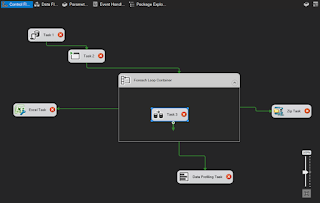Control Flow
Control Flow
A package consists of a control flow and, optionally, one or more data flows. SQL Server Integration Services provides three different types of control flow elements: containers that provide structures in packages, tasks that provide functionality, and precedence constraints that connect the executables, containers, and tasks into an ordered control flow.
You create the control flow in a package by using the Control Flow tab in SSIS Designer. When the Control Flow tab is active, the Toolbox lists the tasks and containers that you can add to the control flow.
The following diagram shows the control flow of a simple package in the control flow designer. The control flow shown in the diagram is made up of three package-level tasks and one package-level container that contains three tasks. The tasks and container are connected by using precedence constraints.
Creating a control flow includes the following tasks:
Adding containers that implement repeating workflows in a package or divide a control flow into subsets.
Adding tasks that support data flow, prepare data, perform workflow and business intelligence functions, and implement script.
Connecting containers and tasks into an ordered control flow by using precedence constraints.
After you add a task or container to the design surface of the Control Flow tab, SSIS Designer automatically adds a connector to the item. If a package includes two or more items, tasks or containers, you can join them into a control flow by dragging their connectors from one item to another.

Comments
Post a Comment